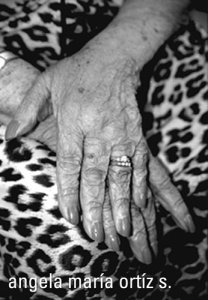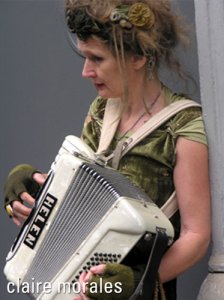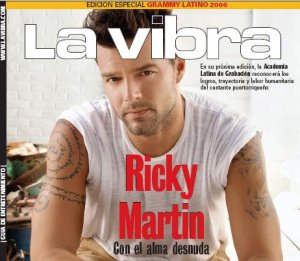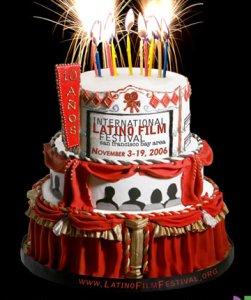Posted by Elena del Valle on November 13, 2006

Tracy Vega, director, Marketing & Publicity, Rio Nuevo Publishers
Photo: Tracy Vega
A podcast interview with Tracy Vega, director, Marketing & Publicity, Rio Nuevo Publishers is available in the Podcast Section of Hispanic Marketing & Public Relations, HispanicMPR.com. During the podcast, she discusses book publishing and Latino markets with Elena del Valle, host of the HispanicMPR.com podcast.
As a native of Arizona, Tracy has spent a life immersed in the diversity of cultures in the American Southwest. She received a BA in English and in Creative Writing from the University of Arizona. While pursuing her degree, Tracy interned with the University of Arizona Press Marketing Department and got a taste of the publishing industry.
Prior to her career in the field of publishing, Tracy’s work experience included tending bar, waiting tables and Early Intervention for the Arizona Department of Developmental Disabilities. She feels each job has enriched her effectiveness to interact with individuals across the boundaries of ethnicity, socio-economics, and ability.
In 2003, Tracy accepted a position at Rio Nuevo Publishers. During her time as Director of Marketing and Publicity, she promoted many award winning books such as Birds of Prey in the American West, winner of the Mountains & Plains Booksellers Association Best Art Book (2004); Voice of the Borderlands winner of the Western Spur Award in Poetry (2006) and most recently, Yard Full of Sun: The Story of a Gardener’s Obsession That Got a Little Out of Hand winner of the American Horticultural Society Book of the Year Award (2006).
She is currently working on Rio Nuevo Publisher’s most recent release A Taco Testimony: Meditations on Family, Food and Culture by award-winning author Denise Chávez, and the upcoming title, The Reaper’s Line: Life and Death on the Mexican Border, scheduled for publication September 2006. Tracy lives with her son in Tucson, Arizona.
To listen to the interview, scroll down until you see the “Podcast” on the right hand side, then select “HMPR Tracy Vega” hit the play button or download it to your iPod or MP3 player to listen on the go, in your car or at home. To download it, click on the arrow of the recording you wish to copy and save to disk. The podcast will remain listed in the November 2006 section of the podcast.
A Taco Testimony by Denise Chavez (Rio Nuevo, $16.95)
Click here to buy A Taco Testimony: Meditations on Family, Food and Culture
Click the button to hear the podcast:
Click here to sponsor a HispanicMPR.com podcast
Posted by Elena del Valle on November 10, 2006

Love by Wanda Benvenutti
Photos: Wanda Benvenutti, Angela María Ortíz S. and Claire-Morales
Los Angeles, California — The work of six Latino photographers will be part of a the Cactus Gallery’s upcoming exhibit, “Shut Up & Shoot: A Photography Show of Unexpected Moments.” The show will open November 11, 2006 in Eagle Rock in Northeast Los Angeles. An artist’s reception will be held Saturday, November 18, 2006 from 7-10 p.m.
“Shut Up & Shoot” features eleven photographers from the Los Angeles area and Washington State. Although the photographers come from diverse backgrounds, they share common ground in their passion for shooting everyday life. The photographs were chosen for their intensity meant to make the viewer pause and look.


JC’s Hands by Angela María Ortíz S. and Accordion Player in NY Subway by Claire-Morales
From Andrew Ward’s shot of the glaring eyes of a young boy inhaling glue, to Wanda Benvenutti’s emotionally charged “Love,” and Aurelio José Barrera’s accordion player on a street in Boyle Heights, the gallery staff believe the images will stay engrained in the visitor’s mind because of their depth and humanness.
“We seek to inspire and enliven the community by giving opportunities to experience the eclectic diversity that is the arts. In our creative space, we’ve enjoyed the spontaneity of live drawing; live painting and live music. Cactus is ever evolving and ready for the next idea,” said Sandra Mastroianni, gallery director and owner.
Los Angeles resident photographer, Angela María Ortíz S., who is originally from Panama, was the curator and organized the display in the show. Other photographers are: Ariana de Lena, Domenico Foschi, Kevin Gray, Claire Morales, Aja Kai Rowley, David Saucedo and Lorena Villegas.
Posted by Elena del Valle on November 9, 2006

Turbulence Advertising ad
Photo: Turbulence Advertisting
Miami, Florida – Turbulence Advertising won several Create Awards from Create Magazine, including the Best of Industry in Advertising award for ad copy. The agency was also recognized with Gold awards in the following categories: Advertising Body Copy, Collateral Advertising, Postcard, Self Promotion, Corporate I.D., and Editorial Design Newspaper Cover.
Turbulence received the Self-Promotion recognition for its Corporate ID package and the Editorial Design for Newspaper award for the Manifesto cover design for Miami’s newsweekly, the SunPost. That same entry has also earned the agency awards at the New York Festival, Davey Awards and the Miami Addy’s. Turbulence executives believe the agency’s “open culture” is paramount to its success.
“The Create Awards was launched to showcase the amazing work being done by companies like Turbulence,” said Jerry Brown, publisher and editor of Create Magazine. “Our judges, from multiple creative industries, judged entries based not only on the freshness of the concept/piece, but also its ability to engage the audience. The multiple wins by Turbulence shows that they know how to do that very well.”
Any paid creative work produced for commercial purposes which appeared in the marketplace between January 2005 and June 2006 was eligible for an award. Nineteen judges picked the winners in 10 industries, 40 categories, and 300 subcategories from among 1,500 entries.
“Continuing to be recognized for our work is very satisfying, but even more so when it is acknowledged by industry peers, such as Create Magazine, that truly value the power of great ideas and creativity to solve business challenges,” said Tom Moleta, Turbulence president.
“Ideas happen, but you have to create the right atmosphere and culture to provide smart people the opportunity to generate great ideas,” said Jose Reyes, partner and creative director. “We’re proud that our hard work has paid off, but more importantly, we have fun doing it.”
Founded in January 2005, Turbulence is a “strategic and creative agency, focused and committed to developing breakthrough ideas and solutions to shake things up and move brands to a better place within their business category.” Turbulence’s clients include The Collection, Miami City Ballet, Humana Healthcare, SunPost, Benihana, Doraku Sushi, Ocean Drive magazine, Euphoria Water, Food and Drug Administration and pro bono work for HELP, Inc. and Suited for Success.
First published in 2001, Create Magazine is a quarterly publication that provides creative professionals with an insider’s perspective on the people, news, trends and events that influence the local advertising and creative production industries. With editions in 16 markets nationwide, each issue features articles by local community leaders on the Advertising, Design, Printing, Photography, Film & Video, Animation and New Media industries.
Posted by Elena del Valle on November 8, 2006

La Vibra Grammy Latino 2006 cover
Photo: La Vibra
Los Angeles, California – ImpreMedia recently launched La Vibra, a weekend entertainment publication, and LaVibra.com, a companion website targeting young urban Latinos with original content, music and movie coverage, interviews with artists, and gossip, as well as information about local entertainment news, clubs and concerts. La Vibra will be distributed weekly in Los Angeles, New York, Chicago, San Francisco Bay area, Orlando and Tampa.
La Vibra hopes to have a significantly expanded distribution with online access and print distribution of 530,000 in six key Hispanic markets. The publication will reach Latinos through ImpreMedia’s newspapers. Thursdays it will be included with La Opinión in Los Angeles, El Diario La Prensa in New York, La Prensa in Orlando and La Prensa in Tampa. Fridays it will be in La Raza in Chicago and Sundays it will be in El Mensajero in the San Francisco Bay Area.

Monica Lozano, CEO and publisher, La Opinión
“With its original content and dedicated entertainment editorial teams across the country, La Vibra brings exclusive entertainment stories for those who want to be-in-the-know about the hottest and latest entertainment news,” said Monica Lozano, CEO and publisher of La Opinión. “La Vibra delivers to entertainment aficionados a wide array of entertainment choices in their backyard. For anyone looking to be well-informed about local and national entertainment, they need only to turn to La Vibra.”
In Southern California, La Vibra has been published in La Opinión every Thursday since 2000. The company plans to offer content from all ImpreMedia markets, along with interviews and interactive features such as audio, video and photo-galleries on the La Vibra website.
To create awareness and buzz for the new entertainment publication, a teaser promotional campaign will commence in the Latin Grammy issue and 12 winners, two winners in each market and two winners on LaVibra.com, will be selected to receive an iPod nano between October 26 and November 19. The campaign will be promoted online with banners and emails to online users.
ImpreMedia publishes Spanish-language newspapers in six Hispanic markets: La Opinión and La Opinión Contigo in Los Angeles, El Diario La Prensa and El Diario Contigo in New York, La Raza in Chicago, El Mensajero in the San Francisco Bay Area and La Prensa in Orlando and Tampa.
Posted by Elena del Valle on November 7, 2006

Eduardo Perez, president of PM Publicidad
Photo: PM Publicidad
PM Publicidad, an Atlanta full-service Hispanic agency, recently became an affiliate of the San Jose Network (SJN). The three and a half year-old marketing firm is one of 25 agencies in the network of marketing communications firms serving the United States and Latin American markets.
“We now have access to a lot of resources and we have access to a lot of network,” said Eduardo Perez, president of PM Publicidad. “We have the ability to pick up the phone and help people in certain situations or someone who’s part of the network but hasn’t worked for the agency. It gives us additional credibility when we talk to new clients.”
PM Publicidad reaches the Hispanic market through print and broadcast production, event planning and management, media planning, direct marketing, and market research. Its clients include NAPA, Georgia Poison Center, American Society, Arby’s, Georgia Lottery, and others. It has also produced television and radio spots for the Oscars.
“We started from scratch with a lot of people who didn’t have agency experience,” said Perez. “The fact that we succeeded in Atlanta, which wasn’t considered a top Hispanic market at the time we started, is what we’re proud of, succeeding despite challenges.”
Agency executives are also proud of the company’s impact on Atlanta’s fast growing Hispanic community. “We’ve raised the profile of Atlanta. We’re the only full-time Hispanic agency in the city,” said Perez. “This speaks a lot to the importance of Atlanta, where the Hispanics are fast growing and the city has been ranked third in Fortune 500 magazine’s top Hispanic markets. We’ve raised the level of awareness for Atlanta.”
The San Jose Network has affiliate agencies in 25 countries, including the U.S., Mexico, Central America, South America, Puerto Rico and the English-speaking Caribbean. The network started in 1991 as part of the San Jose Group. — Sergio Carmona
Posted by Elena del Valle on November 6, 2006

John Mayerhofer, founder and CEO, VoiceIndigo
Photo: VoiceIndigo
A podcast interview with John Mayerhofer, founder and CEO, VoiceIndigo is available in the Podcast Section of Hispanic Marketing & Public Relations, HispanicMPR.com. During the podcast, he discusses mobile phone audio products and the Hispanic market with Elena del Valle, host of the HispanicMPR.com podcast.
John has more than 15 years of experience in the software industry, including twelve years of experience in international general management, executive level sales management, and marketing roles dealing with emerging market software products and geographies. Prior to founding VoiceIndigo, John was vice president of Worldwide Sales at Westbridge Technology, a leading XML web services security infrastructure company, and a member of their founding management team. John’s focus during much of the 1990s was Internet electronic commerce.
Prior to Westbridge, John was vice President of International Operations for Comergent Technology, where he led their efforts to establish field operations in markets outside of North America. John was the founding member of BroadVision’s European executive management team where he started and managed various BroadVision businesses in Europe and the Middle East.
Prior to BroadVision, John managed Gain/Sybase’s interactive new media sales efforts in Europe and developed software as an engineer at Oracle Corporation. John is also co-founder of Clearport Technology Group; a non-profit organization that provides on-demand hosted application technology to socially oriented non-profits. John graduated Magna Cum Laude from the University of Illinois, Champaign-Urbana with a Bachelors of Science in Chemical Engineering.
To listen to the interview, scroll down until you see the “Podcast” on the right hand side, then select “HMPR John Mayerhofer” hit the play button or download it to your iPod or MP3 player to listen on the go, in your car or at home. To download it, click on the arrow of the recording you wish to copy and save to disk. The podcast will remain listed in the November 2006 section of the podcast.
Click the button to hear the podcast:
Click here to sponsor a HispanicMPR.com podcast
Posted by Elena del Valle on November 3, 2006

America 101 DVD cover
Photo: Fobia Films
Immigration has become one of those subjects people stay away from in order not cause conflict. Those who touch on the subject are ready for debate. They come prepared with statistics and family anecdotes, all politically correct of course. Not everyone has the boldness of comedian Carlos Mencia who will openly make fun of the process and the immigrants themselves. Mencia believes we take ourselves too seriously and we need to laugh more often, even at our own expense.
According to promotional materials, America 101, is on the same track as Mencia, although not as bold and not offensive. Rather than trying to drill the seriousness of the matter with lectures and statistics director Mark A. Russell chose laughter for his film. When speaking after a screening Russell described his strategy, “Most people would rather be tickled than hit over the head with facts.”
The film chronicles brothers Angel (Miguel Castro) and Carlos (Miguel Azurdia) taking a journey in order to reach the American Dream. In an effort to save the family business they leave Mexico. After a few comical events they find their way to Tucson, Arizona. Although they make it into the United States, an ironic twist causes them to make their way back to Mexico.
As the writer and director of the film Russell made it a point to not take away from the considerable danger undocumented immigrants face when crossing the border. America 101 is an effort to show the realness of the immigrant’s story without turning it into a documentary or a political statement.
The film has been shown throughout the country at various film festivals. It was an Audience Award Winner at the Golden Film Festival in Golden, Colorado. it is also available at retail and rental outlets. — Melissa Gonzalez
Posted by Elena del Valle on November 2, 2006

Happy Birthday Bear card cover
Photo: Lantigua Designs
Weston, Florida – Lantigua Designs, a Florida-based company specializing in Hispanic greeting cards, was chosen to participate in this year’s celebrity gift baskets for the 7th Annual Latin Grammy® Awards. The event, which will take place November 2 in New York City, will be televised on the Univision Network. Some of this year’s Latin Grammys nominees are Shakira, Chayanne, Ricardo Arjona and Fonseca.
“We are very honored to have been chosen for the Latin Grammy celebrity gift baskets,” said Liz Lantigua, creative director and founder of Lantigua Designs, Inc. “This is a great opportunity for all those in the Latin community to know about our products which are so unique and in tune with the Hispanic culture.”
The official talent gift basket will be given to presenters and performers at the Latin Grammy Gift Lounge backstage throughout rehearsals. The famous gift baskets are known to overflow with coveted items ranging from fashion and beauty to electronics and toys. They are chosen and prepared by Distinctive Assets, a company that creates gift baskets for Hollywood events.
Lantigua Designs was created in 2004 to offer Hispanic-themed, Spanish language and bilingual greeting cards that appeal to U.S. Hispanics. The line of cards available is: Birthdays; Dicho Cards based on popular Spanish sayings; All Occasion; Blank Note; Religious; Blank Note Cards such as: Latina and Loving It©, Cubanita That’s Me©, and Kids/Teens greeting cards and party invitations. Lantigua Designs’ cards are available in retail stores in South Florida, New York and Maryland.
Posted by Elena del Valle on November 1, 2006
10 International Latino Film Festival
Photos: International Latino Film Festival
The 10 annual International Latino Film Festival (ILFF) will take place in the San Francisco Bay area including San José, Mill Valley, Oakland, San Bruno, San Rafael, Larkspur, Berkeley and Redwood City November 3-19, 2006. Festival attendees will have an opportunity to see 85 films at seventeen venues during this year’s event.
Movies scheduled in this year’s Festival include “Ni muy, muy… ni tan, tan… simplemente Tin Tán,” “The Virgin of Juarez,” “Lalo Guerrero, the Original Chicano,” “Madeinusa,” “Maquiapolis, City of Factories,” “To the Other Side,” “American Visa,” “My Best Enemy,” “Loving Maradona,” “The Uncertain Guest,” “Till the Last Drink… My Heart” and “Sea of Dreams.” The movies are from Argentina, Bolivia, Chile, Mexico, New Zealand, Peru, Spain, and USA.
Samba School
Official Sponsors for the Festival include Dominican University of California, Macy’s, Castellano Family Foundation, Latino Leadership Council/City of Redwood City and Continental Airlines. Major sponsors are Visa, Wells Fargo, Union Bank, Don Julio, Prudential of California, Pru-Latino, JW Marriott and Mexicana Airlines. Supporting Foundations Sponsors are Grants for the Arts, James Irvine Foundation, Marin Community Foundation, Fullerton Family Foundation, County of Marin Board of Supervisors, Alexander M. and June L. Maisin Foundation of the Jewish Community Endowment Fund.
The ILFF began as a grassroots organization ten years ago, presenting 10 films at a single venue. The Festival showcases new international Latino cinema, encourages emerging talent and pays tribute to celebrated Latino actors, directors and producers. ILFF programs include documentaries about the Latino experience in the United States, the Jewish culture in the Hispanic world, Women & Film series and music, art and human rights themes.
The International Latino Film Festival was founded in 1997 by Sylvia Perel to benefit the San Francisco Bay Area by promoting cinematography of significant artistic merit created by, or about Latinos; and to celebrating cultural understanding through the art of film and filmmaking. The International Latino Film Festival began in Marin County with eight films over three days in one venue and has grown to 85 films over 16 days in 17 venues and nine cities across the Greater San Francisco Bay Area.
Posted by Elena del Valle on October 31, 2006

Fernando Espuelas, Voy CEO
Photo: Voy
New York, New York — To reach the highly desirable 16 million Hispanic Internet demographic Voy LLC launched a broadband network, Voy TV. It is promoted as the first broadband television network to combine programmed content with user-generated videos and sharing tools. On the launch date, the homepage is populated mainly by video content with a handful of Voy blogs and podcasts. According to promotional materials it is designed to be a next generation destination for Latinos seeking an “entertaining and social experience.”
The company uses broadband, wireless, television, film, music, and DVD tools to reach consumers and hopes this diversity will attract content creators and advertisers. Voy TV executives hope to attract its Voy Plaza base of 2.6 million. The company promises a combination of acquired original programming, licensed content and user-generated video; including thousands of videos arranged in an array of user-generated and premium channels where visitors can share video clips, create blogs and meet other Latinos.
“Voy was conceived as a brand, independent of any particular method of distribution, recognized for its ability to bring entertainment that resonates with the Latin mindset to audiences that are increasingly turning to digital media,” said Fernando Espuelas, founder and CEO of Voy. “Voy TV takes advantage of broadband distribution to reach this underserved audience and connect with millions of viewers hungry for relevant content and social networking.”
Select Voy premium channels include: Voy Filmmaker Showcase with short films, music videos and commercials made by Latinos or featuring Latinos; LatinEyes, a licensed broadcast magazine show, about Latin culture; Voy to Hollywood with celebrity interviews, and behind-the-scenes news on movies and shows that interest Latinos; LatinoCam, a weekly series, invites Voy members to be virtual reporters for news, current affairs and entertainment; Hola America!, a news magazine series about Latino personalities making an impact in the United States.
Voy, Spanish for “I go,” is a digital media company targeting English-speaking Latinos. The company was founded in 2003 and has offices in New York, Los Angeles, Miami and Buenos Aires.
Comments:
Filed Under: Media
























